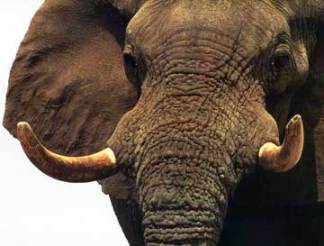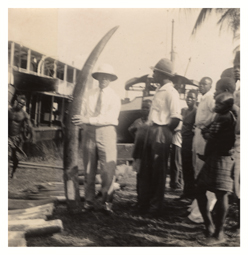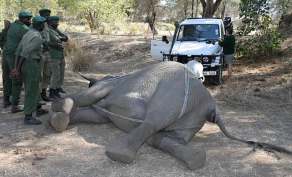From Africa to Hong Kong, a Hidden Trail of Illegal Ivory
By Stephen Brookes in Nairobi
for Insight Magazine
When delegates to the Convention on International Trade in Endangered Species (CITES) gathered in Lausanne, Switzerland, in October to debate the future of the African elephant, it was clear they were readying for an ugly fight.  In one camp, an alliance of Western conservationists and a majority of African countries was demanding that the elephant be granted endangered species status, a move that would stop legal trade in ivory and pull the plug on the illegal poaching that has halved Africa's herds in the past decade. In the other camp, a cozy cartel involving South Africa, Zimbabwe, Botswana and Japan was equally determined to see the profitable trade continue. Before the planes even hit the ground, the two sides had locked tusks.
In one camp, an alliance of Western conservationists and a majority of African countries was demanding that the elephant be granted endangered species status, a move that would stop legal trade in ivory and pull the plug on the illegal poaching that has halved Africa's herds in the past decade. In the other camp, a cozy cartel involving South Africa, Zimbabwe, Botswana and Japan was equally determined to see the profitable trade continue. Before the planes even hit the ground, the two sides had locked tusks.
Banning trade was a wrongheaded policy, the southern Africans argued, because it robbed elephants of the very value that ensured their survival. Making them economically worthless merely meant that native populations, who compete with the elephants for land and who sometimes see them as pests, would not hesitate to kill them off.
The "elephanatics" in East Africa should do what Zimbabwe and South Africa do, they advised: cull a percentage of their herds every year and sell the ivory, meat and hides on world markets. Since those profits could be plowed back into protection, conservation and rural development, the ivory trade actually protected the elephants and helped the economies of the countries that owned them. Besides, they said, outlawing legal trade would only push up the price of ivory on the black market making the poaching problem worse.
But conservationists countered that continuing the limited trade would open a pipeline for poached ivory, allowing the smuggling networks that control the trade (and make most of the money from it) to thrive. Both Zimbabwe and South Africa have had abysmal records in policing well-known smuggling routes through both countries. And given the immense money to be made in smuggling, said many conservationists, it was unrealistic to think anything short of a total ban would work.
After a week of acrimonious debate, the signatories voted to put the elephant on the list of endangered species and to end all international trade in ivory. Zimbabwe, Mozambique and Botswana took reservations from the decision, saying they would continue to trade. But in a turnaround that caught many by surprise Japan said it would respect the ban; and with the American and European markets effectively closed, the southern African countries will have a tough time finding buyers for their ivory.
The decision came at a time of precipitous decline in the number of African elephants. Due almost entirely to a rash of poaching to feed a thriving illegal ivory market, their numbers have dropped from 1.3 million 10 years ago to 630,000 today. As the price of ivory rose from $2.50 a pound in 1960 to $14 a pound in 1973 and as much as $170 a pound early this year, the elephant became a quick and easy source of income. The civil wars and instability in many African countries only threw fuel on the fire: As automatic weapons became commonplace from Somalia to Chad to Namibia, the rate of the slaughter reached 2,000 a week.
Put an end to the ivory trade, conservationists warned, or the African elephant could become extinct in as little as 20 years. "What we've seen in the past decade is one of the greatest mammalian holocausts in this century," says lain Douglas-Hamilton, a consultant to the World Wildlife Fund, who has studied the elephant in Africa for several decades.
Under pressure from people like Douglas-Hamilton, the world began to take notice. In 1986 the trade treaty group voted to move the elephant onto the list of threatened species -- one grade below endangered -- and drew up a system to ensure that only legally obtained, government-approved ivory would be traded in world markets.
It was a good idea, but it quickly turned into a fiasco: Well-financed ivory traders soon figured out how to get around the restrictions, and the convention-sanctioned legal trade soon became little more than a front for a flourishing international business in cut-price, poached ivory.
The 300 tons of ivory that left Africa legally last year amounted to only a tiny fraction of what ended up on world markets. By most accounts, some 80 percent of the ivory trade has been in poached tusks (Tanzania says it is closer to 94 percent), fueling a trade worth as much as $500 million a year.
Little of that money ever returned to Africa; the profits stayed with powerful and secretive trading syndicates based in Hong Kong and Singapore – groups that ran elaborate operations stretching from Africa's wildlife reserves and hidden factories in Dubai to the traditional carving centers in Hong Kong and Japan.
The illicit trade was able to spread because of deep flaws in the 1986 convention's controls, which tried to limit exports of raw tusks with a quota. To keep poached ivory off the market, all tusks were to be weighed, registered and marked, and their progress through the trading system tracked on a central computer. The convention's signatories agreed not to import tusks not properly certified under the new system.
But the system proved to be fatally flawed. The key loophole was that the controls applied only to trade in raw, uncarved tusks. That meant that simply by smuggling the poached ivory into a non-signatory country and carving it into rough sculptures, a trader could slip it into the licit, convention-sanctioned trade. Once delivered to carving shops in Hong Kong, Japan or Taiwan, where it received elaborate carving from the experts, it was impossible to distinguish from legal ivory.
Since 1986, that single flaw fueled a steady stream of poached tusks out of Africa and into rough-carving shops in the Middle East, Singapore, Taiwan and Macao. Until very recently, the favored carving haven was the Jebel Ali Free Trade Zone in the autonomous emirate of Dubai, one of the seven United Arab Emirates that stretch along 400 miles of the southern Persian Gulf. 
Workers at a carving factory in DubaiDubai, which had signed and later repudiated the convention agreement, until earlier this year played the role of a willing host to several major Hong Kong traders who set up large carving factories to get around the endangered species treaty's regulations. These factories ran from early in the morning until midnight every day, employing some 65 carvers from Hong Kong and a number of semiskilled carvers from the Asian subcontinent. According to reports from the area, they were closed down late last year, and Sheikh Qassim Sultan, the acting chairman of the Dubai City Council, announced in June that trade in ivory would henceforth be banned.
But Dubai is only one of the United Arab Emirates, and trade is said to have continued unabated in the region. When the factories closed in Dubai, say investigators, equipment was moved to the neighboring emirate of Ajman; there are thought to be about a dozen factories there now.
Two of the most notorious traders, the Hong Kong-based brothers Tat Hong Poon and Tat Wah "George" Poon, are believed to have dominated the illicit ivory trade for years. George Poon registered the ivory carving factories in Dubai, owns shares in the family-owned Fung Ivory Factory in Singapore (where investigators say much poached ivory has been shipped), has bought ivory from Kruger National Park in South Africa and is reported to have been to Tanzania to inspect poached ivory. Tat Hong Poon, according to the London-based Environmental Investigation Agency, imports and markets the ivory that his brother's activities provide. Both Poons refuse to speak to the press.
The traders were able to take advantage of other flaws in the system created by the Convention on International Trade in Endangered Species. A key problem had been that each country was free to set whatever quota it felt like setting, according to any criteria it chose. That opened up the system to wide abuse: A country willing to play along with the big money smugglers would simply allot itself a massive quota and sell the certification to anyone with ready cash.
A third flaw allowed countries to have any ivory seized from poachers certified by the convention and enter the legal trade, meaning that a lot of the so-called legal ivory in circulation came from poached elephants. The pact also allowed a country, once it had joined the system, to have its illegal stocks certified, a move that had the same effect. That flaw enabled Hong Kong money men to quickly tighten their grip on the trade.
The turning point came in 1986, when the convention Secretariat gave a complete "amnesty" to 89 tons of ivory in Burundi and 270 tons in Singapore in exchange for a promise that both countries would join the convention. The ivory in question had all been poached; Burundi, which for several years had a population of exactly one elephant, was Africa's largest exporter of ivory in the mid-1980s, sending out up to 100 tons a year smuggled from Zaire, the Central African Republic, Uganda and elsewhere.
The decision to certify the Burundi and Singapore ivory meant that the endangered species trading system "never really had a hope of working," says David Currey, associate director of the Environmental Investigation Agency.
"They gave a present of millions of dollars and a large number of permits to people who, by their ownership of the ivory, were obviously implicated in the illegal trade."
Since legal, certified ivory sells for as much as five times the price of poached ivory, the owners made huge profits overnight. With that ivory in their control, says Currey, "they could control the whole ivory trade in the Far East. They could push the price up by withholding it, and it meant that any trader who went to Africa to legally buy ivory just couldn't compete." The traders could also use their profits to set up more carving centers in Dubai and Taiwan.
The traders could also use their profits to set up more carving centers in Dubai and Taiwan.
"One trader in Hong Kong recently told me that after the 1986 amnesty he couldn't go to any legitimate place to buy ivory," says Currey. "By the time he'd carved it, it would just be too expensive to compete on the market, so he either had to close his business down or buy semi-finished products from Dubai, where they were sold for about 20 percent of the legal ivory price. So he was forced, if you will, into going along with the new system set up after 1986, where the illegal traders were ruling the whole thing."
While the Hong Kong traders were very heavily involved in most of the illegal trade, they enjoyed discreet but substantial support from Japan, says Currey.
"Some Japanese traders have put up the money to Hong Kong traders who use that as capital to order ivory, whether it's to feed into the factories in the Middle East or to feed into factories in Macao or Taiwan or Singapore. They've been dealing with a number of Hong Kong companies for most of their ivory, and those companies, almost without exception, are the same ones who have been running the illegal trade. Some of the Hong Kong traders are starting to speak out, saying that Japanese traders were putting 20 percent of the money up front, placing orders for people like Poon to go and get ivory for them, no questions asked."
While the high price of ivory fueled poaching, the proliferation of high-powered weaponry across Africa made it possible on a grand scale. Poachers in earlier decades had to rely on single-shot guns-or even spears to hunt elephants, but the poachers now have AK-47s, G-3s, even RPG-7 rocket launchers.
"It first became apparent that this was a real problem in 1982, when I was serving on the Uganda anti-poaching force," says Douglas-Hamilton. "We were faced with a proliferation of automatic weapons after the civil war that had just taken place. When Amin's troops retreated from Uganda, they abandoned their guns or sold them to the local people, who began to poach. And it's the same in Somalia, where a lot of weapons were distributed at the beginning of the Ogaden war in 1977, and it's the same in southern Sudan, Angola, Mozambique. Wherever you get a war, you get loose weapons. And they get turned on elephants."
The path of destruction has been wide. Chad's herds have been slashed since civil war broke out in 1979; Uganda has only 1,500 to 2,000 elephants left from the 20,000 that roamed in the Sixties - most cut down by trigger-happy soldiers during Idi Amin's rein.
In Angola, UNITA rebels have killed tens of thousands of elephants - as many as 100,000, by some estimates. (UNITA leader Jonas Savimbi told Paris Match last year that he had financed much of the 13-year war effort with teak and ivory sales; the South African Defense Forces confirmed last December that it had transported "small quantities" of ivory on behalf of the rebels for several years in the late Seventies.)
A plane taking off from an Angolan rebel camp in late September crashed with the son of Portugal's president and a huge load of ivory on board. And in Mozambique, where the government has been fighting Renamo guerrillas since the mid-1970s, the elephant numbers have dropped from 55,000 to fewer than 17,000. More than 50 tons of ivory - the product of more than 5,000 elephants - was captured by government troops when they overran several Renamo bases.
One country that has posed particular problems, especially for Kenya, has been Somalia. While it was one of the first countries to propose that the elephant be placed on the endangered species list, its record as a conservationist has been questionable. Although it currently has only about 4,500 elephants, Somalia has managed to export tusks from close to 14,000 since 1985. Somalis have traditionally been poachers and hunters and can be found in large swaths of East Africa, even as far south as Kruger National Park. Known as shifta, they've had a reputation for banditry in eastern Kenya since the Sixties, and were responsible for the killing of the well-known conservationist George Adamson in Kenya. Almost all of the poachers captured or killed by Kenyan authorities in recent years have been well-armed Somali nationals, but authorities suspect that their numbers are not that large.
Somalis have traditionally been poachers and hunters and can be found in large swaths of East Africa, even as far south as Kruger National Park. Known as shifta, they've had a reputation for banditry in eastern Kenya since the Sixties, and were responsible for the killing of the well-known conservationist George Adamson in Kenya. Almost all of the poachers captured or killed by Kenyan authorities in recent years have been well-armed Somali nationals, but authorities suspect that their numbers are not that large.
"It's hard to say how many are out there," says Richard Leakey, head of Kenya's Wildlife Service, "but I don't think you're talking about more than 100 people throughout the country."
The poachers, who travel in gangs of as few as three or as many as 60, are the bottom rung of the smuggling networks. They have to spend weeks in the bush and rarely make more than $5 a pound for the ivory. With shoot-to-kill policies in effect in Kenya, Tanzania and some other countries, they risk their lives every time they pick up a gun. "The guy who gets the worst deal - after the elephant - is the poacher," says Leakey. "He's the least paid, takes the greatest risks and has the hardest life."
A typical operation will spend days stalking a herd, then move in for the kill. Once the elephants are downed, the tusks are removed as quickly as possible, often by hacking off the animal's entire face. The raw tusks are then moved on foot to the outskirts of the park and buried.
Dug up later by the smugglers, they will be sent by truck or camel on one of several main smuggling routes; tusks from southern African countries often move down a well-established route that runs through Lusaka in Zambia, crossing into Botswana at the Kazungula border post, then into South Africa at Martinsdrift. From there the ivory goes to Johannesburg, where some is loaded onto planes and flown to Hong Kong, Taiwan or other points east, and the rest is sent on to the coastal towns of Durban, South Africa, or Maputo, Mozambique, to be loaded onto ships.
The South African connection, investigators believe, is key to the illegal trade. A recent documentary by the South African Broadcasting Corp. noted that 50 tons of ivory was exported from South Africa last year, all of it properly documented and apparently legal. But, said the documentary, only 7 tons had been culled from the country's parks and another 7 tons brought in legally; fully 72 percent of the country's exports came from unexplained sources.
There are other routes out of Africa as well. In the recent past, for example, large amounts of East African ivory were trucked overland into Burundi and shipped by air from Bujumbura to Dubai (often with the country of origin labeled as Tanzania). That route, while diminished, still exists. Another way has been to pack the ivory in sacks of grain or sugar and transport it overland through southern Sudan to Addis Ababa in Ethiopia. An even more common method, though, is to load the ivory onto small sailing vessels known as dhows in port cities such as Mombassa in Kenya or Dar es Salaam and Mtwara in Tanzania, and to ship it up to Dubai's Hamfiyyah Port.
The sea routes are thought to be run by Middle Easterners, who will hire a dhow and give the captain instructions on where to pick up the tusks, as well as money to pay for the consignment. Even a couple dozen tusks can make a trip profitable, and a fair amount of the dhow traffic from East Africa to the Middle East is thought to participate. The trip is not terribly risky, and the rewards make it well worthwhile; around Mombassa it is said that if you want to know which dhows are running ivory, look for the ones that are freshly painted.
The trade flows freely, oiled by money. Official corruption at almost every level is widespread, say investigators. Wildlife departments in most African countries operate on minimal budgets, and the rangers who patrol the reserves are poorly paid and badly under-equipped. As the price of ivory rose throughout the Seventies and Eighties, the price of a pair of tusks soon surpassed a ranger's yearly salary - and the temptation to poach became hard to resist.
But corruption spreads above the level of the game warden and low-level customs official, who could be persuaded to turn a blind eye for a relatively small amount.
"Corruption at the highest levels of the governments of Zaire and Zambia has contributed to kills of as many as 200,000 elephants in Zaire and 100,000 in Zambia over the past decade," says Craig Van Note, executive vice president of the Monitor Consortium, a conservation group in Washington. "Much of the ivory is flown out or shipped out without any documentation."
The corruption spreads to government officials and even foreign diplomats. The Tanzanian court of appeals recently increased the sentence of a member of Parliament, Ali Aburi, who had been caught transporting 105 tusks in his official parliamentary vehicle, from nine years in prison to 12. And Hussein Joesoef, Indonesia's ambassador to Tanzania, was arrested with his wife in Dar es Salaam in January attempting to smuggle a container of 154 raw and 24 partly worked tusks onto a flight to Abu Dhabi and Singapore.
No one, apparently, is immune from temptation: a Roman Catholic priest, the Rev. Fidelis Efio, is serving a five-year prison term in Tanzania for possession of 224 poached tusks.
In many parts of Africa, the fight against poaching is being waged like a war. Namibia has been using members of its notorious Koevoet police unit (which gained a reputation for brutality in the 23-year war against the Namibian SWAPO guerrillas) to fight poaching in the Caprivi Strip; they are said to be using the same counterinsurgency techniques against poachers that they used to track guerrillas. And in Zimbabwe, former Rhodesian bush fighters have been fighting poachers in the Zambezi Valley.
Any full reprieve for the African elephant will have to come from a combination of stepped-up anti-poaching measures, more money to African conservation efforts and an end to demand for ivory in the major markets of the United States, Europe and Japan. Of all of these, ending demand is the most important. "It's people who will save the African elephant," says Kenyan wildlife official Leakey. "Not little bits of paper signed in Switzerland."
(Insight Magazine, November 13, 1989)
References (2)
-
 Response: https://funded-traders.com/
Response: https://funded-traders.com/ -
 Response: himbhoomi login
Response: himbhoomi login


Reader Comments